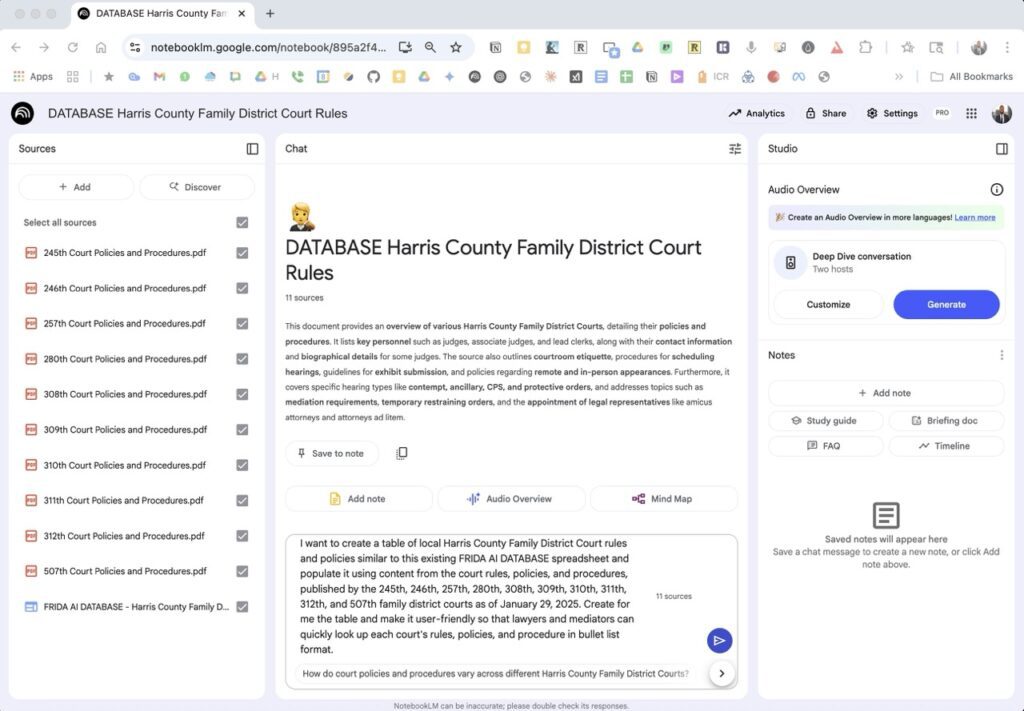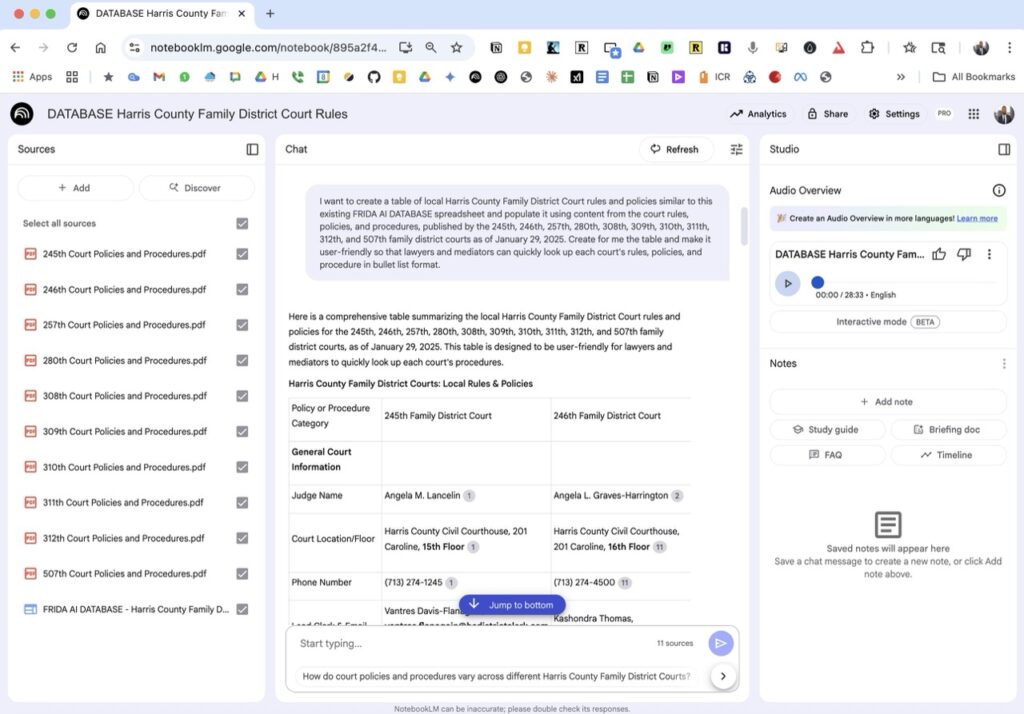Compiling Spreadsheets with AI Using NotebookLM – For Lawyers & Mediators
For any family lawyer or mediator practicing in Harris County, Texas, the routine is all too familiar. You have a hearing in the 308th, are assigned a mediation in the 246th, and a new client whose matter is in the 507th. Each court has its own distinct set of local rules, policies, and procedures. For years, navigating this has meant sifting through a dozen different PDF documents, trying to pinpoint the specific rule you need. It’s a time-consuming, inefficient, and frankly, frustrating process.

This is a problem I’ve tackled before. As I wrote about previously in “If There’s An Itch, Scratch It: Generative AI’s Ability to Transform Access to the Harris County Family District Courts’ Rules,” organizing this crucial information is a perfect use case for artificial intelligence. Today, I want to show you exactly how I took that concept to the next level using the powerful new tool: Google’s NotebookLM.
The result is a comprehensive, easy-to-use spreadsheet of the Harris County Family District Court rules, and you can access it right here: Harris County Family District Court Rules, Policies, & Procedures Spreadsheet.
The data provided in this spreadsheet is not legal advice and it may contain errors. So verify any information for yourself.
The Challenge: Information Overload
The core of the problem is that each of the ten family courts publishes its own rules in separate webpages. Those webpages are periodically updated and the public is expected to stay on top of any changes for each court. I wanted one central resource where I could quickly compare procedures or look up a specific judge’s policies without opening different sites or downloading different docs.
The Solution: Google’s NotebookLM
This is where NotebookLM, a Gemini-powered research and writing assistant, comes in. Unlike a traditional search engine, NotebookLM allows you to upload your own source documents, creating a personalized knowledge base that it can analyze, synthesize, and transform.

Here is the simple, four-step process I used:
1. Gather the Sources: First, I gathered the individual policies and procedures (downloading them as PDFs) for the 245th, 246th, 257th, 280th, 308th, 309th, 310th, 311th, 312th, and 507th District Courts.
2. Create a Notebook: I uploaded all PDFs into a new “notebook,” along with a template spreadsheet that already had some court information from the FRIDA AI project I’ve started last year. NotebookLM immediately processed the documents, making them its sole source of truth for my questions.
3. Craft the Prompt: This is where the magic happens. I gave NotebookLM a specific instruction:
“I want to create a table of local Harris County Family District Court rules and policies…and populate it using content from the court rules, policies, and procedures, published by the [list of courts]. Create for me the table and make it user-friendly so that lawyers and mediators can quickly look up each court’s rules, policies, and procedure in bullet list format.”
4. Generate and Refine: In seconds, NotebookLM generated a comprehensive, formatted table summarizing the key information from all ten source documents. It pulled judge names, contact information, court procedures, and specific rules for topics like temporary orders, mediation, and appointing amicus attorneys.
From there, I simply copied the generated table into a Google Sheet, made a few minor formatting tweaks, and the project was complete. The entire process, from uploading the PDFs to having a functional spreadsheet, took less than 15 minutes. When I previously attempted this project manually in early 2024, it took many hours.
5. Bonus – Share it: You can share a notebook with others, allowing them access to either the full notebook or to just the chat so they can interact with the uploaded sources. Here is the share screen showing what I am sharing with my in-house staff:

A New Tool for a More Efficient Practice
This spreadsheet is more than just a document; it’s a strategic tool. It allows me as a legal professional to:
- Save Valuable Time: Quickly find the information you need without hunting through multiple files.
- Improve Accuracy: The data is pulled directly from the courts’ published rules (until they update it).
- Enhance Preparation: Walk into hearings and mediations fully prepared with the specific court’s procedures at your fingertips.
This is a prime example of how AI can be leveraged to solve the practical, everyday challenges of legal practice. By transforming a chaotic collection of documents into a single, structured resource, we can streamline our workflows and dedicate more time to serving our clients. I encourage you to explore the spreadsheet and consider how tools like NotebookLM might be able to address your practice needs.




